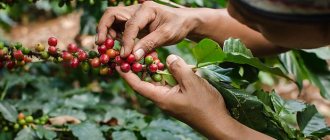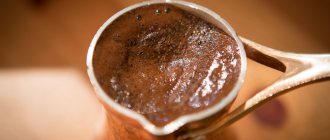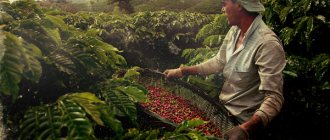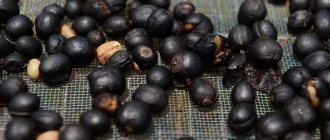07.05.2018
Honey, dry, washed... you've probably wondered, “What do these words mean when describing coffee?” or “Which coffee treatment will suit my tastes best?” Let's figure it out. Coffee processing affects the coffee's flavor profile and balance. There are three main methods of processing grains: washed, natural (dry) and honey (from the English honey - honey). There are alternatives, but they are rarely found in production and are usually a local processing method, such as Wet Hull, also called Giling Basah. We will also tell you about this method.
Washed coffee processing
Washed coffee processing is used mainly in Latin America and some areas of East Africa. It requires cleansing from the top protective layer of the berry and from the adhesive substance covering the skin of the grains themselves, using friction, fermentation and water. After picking, the berries are taken to a water mill. Next, the grains are pulled out of the berry itself using special equipment. At this stage, the grains are covered with a sticky liquid, which includes sugar and alcohols. This sticky substance affects the sweetness, sourness and aroma of coffee. Once the grains are separated from the berries, they are placed in fermentation tanks for 12 to 24 hours depending on temperature, although producers have begun experimenting with fermentation times to create new flavor profiles. For example, prolonged fermentation means that the beans absorb more sugars and therefore taste sweeter. After fermentation, the sticky substance breaks down and leaves the beans covered only with coffee “parchment”—the skin. Now the grains are ready for washing. This is done in tanks with clean water. At the exit, the grains harden, which means they are ready for drying. The grains are dried for approximately 10-22 days, during which they are turned regularly. This slow drying is considered optimal for obtaining balanced coffee. Washed processing focuses only on the grain, it reveals what is inside it, but not what is outside. Many believe that this method reveals the true character of the variety like no other, which is why most specialty coffees are processed this way.
Coffee Processing Methods
Coffee, in terms of taste and aroma, is one of the richest drinks in the world. The slightest differences in cultivation, processing and preparation will affect its quality. Here we will tell you about processing, or rather its types, differences and how it affects the taste of the drink.
Coffee processing is the process of extracting coffee beans from the berry.
There are 3 processing methods:
-Natural (dry)
-Washed
-Half washed
Natural processing method.
The natural processing method is considered classic, because it was also used by the inhabitants of the Ethiopian mountains. They noticed that ripe berries first slowly dry out on the branches, then fall to the ground and dry there. After this, the pulp is easily separated from the grains. But on an industrial scale, waiting for the berry to dry on a branch and the ground is long and impractical. To speed up the drying process, farmers began picking ripe berries and laying the crop in even layers on palm leaves, concrete surfaces or special tables with a grid called African beds.
With this method, the grain is dried without removing the pulp. Coffee berries are rich in moisture, so this process takes 2-4 weeks, depending on the thickness of the layer and the average air temperature in a particular area. During this period, the coffee bean absorbs sugars from the pulp and gluten (the sticky skin that separates the pulp of the berry and the beans themselves), which gives the bean increased sweetness, a bright aroma and a rich fruity taste. The fermentation process begins in the berry, so the grain must be stirred regularly so that drying proceeds evenly. Drying is considered complete when 12% moisture remains in the grain, and the outer shell of the grain becomes dark brown, dry and brittle.
Coffee of this processing has a very bright and intense taste, good richness and increased sweetness. The natural method is the oldest processing method and requires careful attention, as uneven drying can lead to a strong aroma and fermentation taste that not everyone likes.
Washed processing method.
In regions with high humidity, drying coffee is very difficult. Therefore, in 1740, a washed processing method was invented in Java. This is a more complex and complex process.
Initially, freshly picked berries must be peeled and pulped (depulpation). To do this, the grain is placed in a special machine - a depulpator. Afterwards, the adhesive substance with which it is covered is removed from the grain: the grains are placed in a reservoir with water and yeast with special bacteria dissolved in it. This process is called fermentation - bacteria begin to eat the sweet gluten, helping to break it down. The process can proceed without water. During fermentation, the temperature of the grains increases, so they must be stirred so that the temperature does not exceed 40 degrees. This process lasts from 6 to 72 hours depending on the type of coffee, its maturity and volume. The next stage is grain washing. It is driven through locks in which the water is in constant movement. Good ripe grains sink to the bottom, while bad, defective grains float to the surface. After washing, the grain is sent for drying.
Washed processing enhances the acidity of the coffee rather than its sweetness. It is often more balanced and smooth than naturally processed coffee. The grain contains brighter berry and citrus notes. Additionally, the washed process produces a cleaner, “transparent” cup. Coffee of this processing has a characteristic acidic aroma, less pronounced sweetness, and a well-balanced bright taste.
Semi-washed processing method.
There are a huge number of varieties of semi-washed processing; we’ll tell you about one of the most common - honey.
This method combines the two methods listed above in one. The collected berries are first sent for depulpation in the same way as with washed processing, and later they are sent for drying, bypassing fermentation vats, and dried together with gluten in the sun, as with the natural method. The fermentation process occurs directly during drying. Depending on the amount of remaining pulp and the intensity of sunlight, honey-processed grains acquire golden-honey shades: from dark brown to yellow; the less pulp and gluten, the lighter the color. This is how this method got its name Honey (English honey, honey).
Coffee with this processing method has a clear sweetness characteristic of the natural method, a creamy body, like washed grain. In general, coffee processed in this way has a more rounded acidity, it is less citrusy, but more chocolatey and sweeter. The general principle is the following - the more gluten and pulp remains on the grain, the sweeter the taste, the fuller the body; the less, the more acidity, the purer the taste. Among other things, honey processing is also considered more environmentally friendly compared to washed processing, because it uses much less water.
Dry coffee processing (natural)
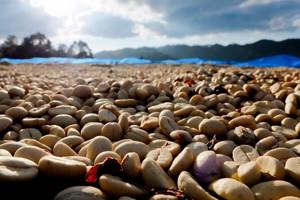
The most ancient method of processing coffee. Traditionally used for large-scale coffee production due to low cost, such as in Brazil, or due to the limited amount of water in the region, such as Ethiopia. After harvesting, the coffee berries are dried in the sun. In large-scale production, they are usually placed on concrete or brick surfaces, sometimes on the ground to absorb moisture. For this reason, when dry processed, the coffee beans will have more defects - even an earthy smell due to drying on bare ground. Washed coffee has always been more expensive due to its purity and balance, but more and more producers are giving preference to naturally processed beans because of the scope for flavor experimentation. When carried out correctly, dried on absorbent surfaces and turned regularly, natural processing can produce a unique coffee taste with hints of strawberry, mango and blueberry in the finish. Drying occurs without clearing the top layers, which allows the berry to ferment naturally. The grains absorb all the substances contained in the berry. As a result, the brewed coffee has an unusual flavor profile. After drying, the berries resemble raisins in appearance, and the grains are cleared of their outer layers. Brewed coffee will have a pronounced sweet taste.
Washed coffee processing method or wet process
Wet process, washed process
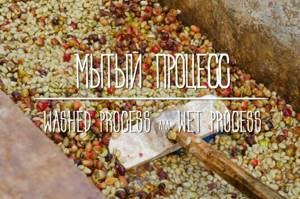
Overall Flavor Profile:
“clean,” which means more of the flavor inherent in the grain.
Well balanced, complex, with pronounced acidity. Silky, delicate, with a variety of flavor shades from notes of tropical fruits to dark chocolate. Most often floral. Regions:
Latin America, Africa. The life path of berries that go through the washed process after harvest is very different from berries processed using the dry method. While "natural" berries remain intact, during the washing process the grains are separated from the berries through a process called depulping. The coffee cherries are placed in special machines, also known as wet mills, in which the beans are depulped through a series of stations. Immediately after harvesting, the berries are placed in a hopper at the top of the mill. Using disc or cylinder machines, the musilage is removed from the berries. At the same time, the first grain sorting occurs: grains damaged by bacteria are lighter than water, so they float and are easily removed from the surface. Good grains are sent to the fermentation tank to “rest” for 36-72 hours. There, during the fermentation process, parchment is removed from the grain. Washed coffee is said to taste “purer,” but that doesn’t mean it’s inherently better. This means that the aromatic nuances inherent in the grain are perceived better. Therefore, washed coffee often boasts more pronounced acidity and the acidity can be increased by acetic acid, which develops organically when the sugars in the pulp react with the environment in the fermentation tanks. However, if pH levels are not kept in check, excess acids can develop during the fermentation process, resulting in overly sour coffee. The balance and complexity of washed coffee is what matters most in the end. Order washed processed coffee roasting at the Mamakofe store.
Honey (semi-washed coffee processing)
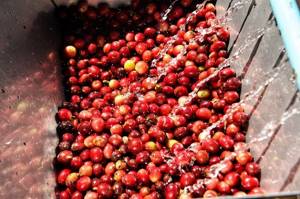
When semi-washed, the coffee tastes literally honey-like, as if brown sugar had been added to a cup of coffee, although the name comes from the similarity in appearance and consistency of the beans to the consistency of honey. This method sometimes confuses roasters and consumers because it varies depending on the country of origin: it is usually somewhere between a washed process and a dry process. Hani processing is a hybrid process that is open to “author’s” interpretations. In Brazil, for example, research was conducted to find a way to process coffee that would use less water than washed coffee, but would be more resistant to defects than natural coffee. This is how they began to use khani, in which the top peel and partly the sticky substance are removed, after which the grains are sent for drying. The coffee turns out sweetish, as with natural processing, while adding a slight sourness to the taste. Central America and El Salvador pay more attention to experiments, so semi-washed processing uses a scientific approach and removes a strictly defined and verified amount of sticky liquid. This precise process of honey processing creates distinctive coffee flavors. The drying process becomes especially important here because the risk of mold and insect damage becomes greater.
Semi-washed processing (honey process)
This method combines the two methods listed above in one. The collected berries are first sent for depulpation in the same way as in the washed method, and later are sent for drying, bypassing the fermentation vats, and dried together with the fruit mucilage in the sun, as in the natural method. The fermentation process occurs directly during drying. Depending on the amount of remaining berry pulp, the honey process is divided by color from black to yellow; the less pulp, the lighter the color. Coffee from this method has the distinct sweetness characteristic of the natural method, a creamy body like washed beans, but a texture close to honey with some fruit flavors and muted acidity.
After processing and chilling, the coffee is sifted through multi-level vibrating sieves to sort the larger beans from the smaller ones. Then they pack and sell.
Wet Hall (Giling Basah)
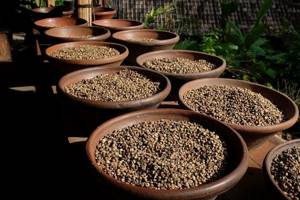
This processing method is commonly associated with Indonesia, where Giling Basah translates to "wet grinding". During this treatment, the coated coffee bean is removed from the berry and then partially dried in the sun until the water content is reduced to 30-35%. The casing is then removed and drying continues until the water content is low enough to avoid mold. After this, the grains become greenish or blue in color, which distinguishes Indonesian processing from all others. This process is not without its challenges: by removing the protective layer at an early stage, the grains may be exposed to insects during the most critical stages of processing. Beans processed in Indonesia are usually associated with woody, earthy or pungent flavors, which are considered to be the result of this unique processing process. Some will admire such shades, while others will consider them a drawback.
Experimentation and innovation: the future of coffee processing
Traditionally, coffee countries have favored one processing method. For example, in Rwanda and much of Central America, washed processing has historically taken hold, while in Brazil, honey or natural processing has been more common. This is now gradually changing, thanks to the increasing demand for specialty coffee. More and more producers are trying other processing methods when natural and climatic factors allow. For example, in Nicaragua, Guatemala and Rwanda, many use honey and natural processing. There's more to it than simply choosing a processing method: some are trying fermentations without oxygen, while others are looking for catalysts to speed up fermentation. Also, many are experimenting for environmental reasons and trying to process grains with minimal use of water. The coffee processing process is not an often covered topic, but it is a fundamental part of the coffee industry. Next time you choose Vietnam's Lam Dong washed process or Brazil's Santos dry process, you'll know what to expect.
Other coffee processing methods
An increasing number of farmers are now willing, where environmental and climatic factors permit, to try other processing methods. For example, in Nicaragua, Guatemala and Rwanda, some farms and cooperatives are turning to natural and honey processing. By doing this, they can create new, unusual flavor profiles that add value to their crop.
Such searches sometimes go beyond simply choosing a processing method: Some producers are experimenting with removing oxygen during fermentation, while others are looking for catalysts to speed up fermentation.
Some are also paying attention to their environmental impact and are trying to recycle coffee while reducing their water consumption. New equipment and knowledge sharing are also helping to create more unique cup profiles.
There is a demand for experimental processing methods. Experts even say that coffee processed using alternative methods “sometimes sells out before the cherries are even picked from the trees.” This means we can expect even more creative processing innovations in the future.
coffee processing
Anaerobic processing of coffee
Anaerobic (= oxygen-free) fermentation is one of the newer methods of coffee processing and has gained popularity, especially among truly high-quality coffees such as competing coffees. The anaerobic process is similar to the washed process, but fermentation is carried out in completely sealed, oxygen-free tanks. The method is still quite experimental, but anaerobically processed coffee often produces wild, unexpected and complex flavors.
Carbon dioxide maceration
This method is similar to anaerobic and has been stolen from the world of winemaking. The biggest difference from the anaerobic process is that the cherries are fermented as a whole, and this process breaks down the cell walls of the fruit pulp from the inside. All the crazy flavors from the fruit pulp are absorbed into the beans during fermentation, and the carbonic maceration produces some extremely crazy and incredible flavors like red wine, whiskey, banana, and bubble gum for the cup.
Giling basah
Giling basah actually sounds like something unrelated to coffee, but it actually means “wet hulled” in Indonesian.
As you might expect, this method is only found in Indonesia. Giling basah is a process similar to the washing process, but the grains are dried to only 30-35% moisture content (11-12% in the washing process). After the initial drying, the parchment is removed from the beans, and then the “naked” beans are dried again until they are dry enough for storage. Giling basah produces earthy aromas such as wood, mustiness, spice and tobacco, which is why it is not highly regarded among coffee professionals.
washing coffee beans
Try our coffee
Mix of grains
Espresso coffee
Blend of 100% Arabica beans. The aroma reveals notes of roasted peanuts and hazelnuts, while the taste is dominated by dark chocolate and walnuts. Soft aftertaste of cocoa and burnt sugar.
Peru
Coffee "Chanchamayo"
Rich and strong coffee with notes of bread in the aroma.
Brazil
Coffee "Santos"
The aroma is dominated by spices and cocoa. The soft nutty-chocolate taste is offset by a slight sourness at the end.
